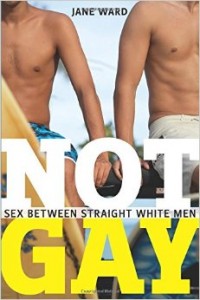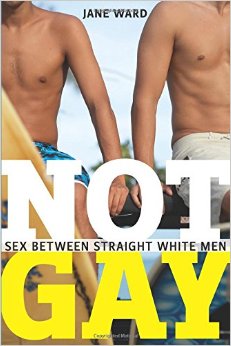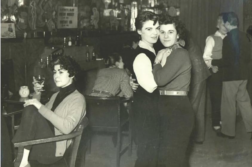 Not Gay: Sex Between Straight White Men
Not Gay: Sex Between Straight White Men
by Jane Ward
NYU Press. 238 pages, $25.
THE TITLE of Jane Ward’s book is not meant to be ironic. Her argument is that while sexual activity between straight white men (SWM) does take place, it doesn’t mean that the participants are gay. The book is about exploring the circumstances under which this situation can be said to arise.
Notions of particular sexual acts fitting a dichotomy between hetero- and homosexual, or some version thereof—the whole notion of “sexual orientation”—is really a modern Western concept, and one that is currently in flux. Many young people today reject sexual labels of any kind. This lack of commitment to a fixed “identity,” in turn, is allowing people to be more open and experimental in their sexual behavior.
The concept of a continuum of sexual orientations started with Alfred Kinsey’s groundbreaking research. The “Kinsey Scale” assumed that sexual orientation forms a spectrum rather than a simple dichotomy, with 0 being completely straight and 6 completely gay. Somewhat surprisingly, Ward mentions Kinsey only in passing. Like Kinsey, she argues that sex between SWM is quite commonplace, but it tends to be confined to particular social situations. Indeed it is Ward’s contention that these situations are ones that have the paradoxical effect of affirming heterosexuality while distancing participants from the same-sex behavior. Thus, for example, hazing rituals that involve homosexual behavior implicitly assume that such performances are an ordeal that inductees will be disgusted by.
Ward identifies three broad categories of same-sex behavior among SWM. The first is “homosexual necessity,” or situational homosexuality, which includes everything from casual sex between dudes when their girlfriends are away to sex in prison or on seagoing vessels when no women are available. Doubtless such outlets have existed forever and have little bearing on our concept of sexual identity.
A more interesting category is “homosocial” activity in which sexual contact plays a role, and here the range of possibilities is vast. It’s surprising how many hazing rituals at fraternities involve homosexual play. One example is the so-called “elephant walk,” in which the naked inductees are forced to form a circle and insert a finger into the ass of the guy in front of them, and then walk in formation. Hazing in the U.S. Navy’s “crossing the line” ceremony involves anal penetration and analingus, among other unlikely activities for heterosexual men.
Ward’s “homosocial” performances in general are a form of social bonding, their origins wrapped up in tribal culture and puberty rites of yore. Whether it signifies a genuine longing for intimacy and bonding with other men is the question. Thus, for example, psychologist Joe Kort asserts that many men possess “a deep longing to experience physical intimacy with other men that they are denied in a sexist and homophobic world.” On the other hand, sociologist Michael Kimmel demotes homosexual longings to a developmental phase, a delayed coming-of-age process that some SWM will pass through. Despite her larger thesis, Ward allows that some straight men have a real desire to engage in homosexual sex, and that the rituals she observed provide a “script of necessity” that allows them to negotiate a heterosexual identity and a desire for sex with men.
The third group is what Ward calls “accidental homosexuality,” which is when guys end up in situations in which both parties are “intoxicated, dumb, or subject to other unusual conditions beyond their control.” This condition is depicted in movies in the so-called “bromance” films, or perhaps in parodies of such films, such as Blades of Glory (2007), in which two zany SWM figure skaters (Will Ferrell and Jon Heder) forge a friendship and “tenderly embrace each other—and each other’s crotches—on the skating rink.” In a very different vein, in the “Jackass” movies an all-male cast (often scantily clad) submits to physical abuse that can involve each others’ nipples or butts or testicles.
Ward devotes a chapter to the sociology of hooking up for SWM in the 1950s and ’60s. Outlets included the bike club Hell’s Angels for working-class men and a range of tearooms and public parks for middle-class men. And yet, at this point we’re talking about men who are actively seeking sex with other men; does there not come a point at which these “SWM” are in fact closeted gay men who’ve yet to come to terms with their sexuality? This question is of course at the core of this book: should these performances be seen as only the enactment of a social script or are they an outlet for authentic same-sex desires? Or are they something else? The prevalence of SM/BD scenarios, violence, and degradation suggests that there’s a strong element of power for its own sake. In other words, as always where sex is concerned, it’s complicated.






